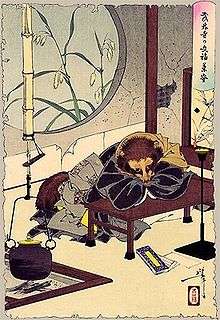Bunbuku Chagama

Bunbuku Chagama (Japanese: 分福茶釜 or 文福茶釜) is a Japanese folktale about a raccoon dog, or tanuki, that uses its shapeshifting powers to reward its rescuer for his kindness.
Story
Bunbuku Chagama roughly translates to "happiness bubbling over like a tea pot". The story tells of a poor man who finds a tanuki caught in a trap. Feeling sorry for the animal, he sets it free. That night, the tanuki comes to the poor man's house to thank him for his kindness. The tanuki transforms itself into a chagama (tea kettle) and tells the man to sell him for money.
The man sells the tanuki-teapot to a monk, who takes it home and, after scrubbing it harshly, sets it over the fire to boil water. Unable to stand the heat, the tanuki teapot sprouts legs and, in its half-transformed state, makes a run for it.
The tanuki returns to the poor man with another idea. The man would set up a circus-like roadside attraction and charge admission for people to see a teapot walking a tightrope. The plan works, and each gains something good from the other—the man is no longer poor and the tanuki has a new friend and home.
In a variant of the story, the tanuki-teapot does not run and returns to its transformed state. The shocked monk decides to leave the teapot as an offering to the poor temple where he lives, choosing not to use it for making tea again. The temple eventually becomes famous for its supposed dancing teapot.
In popular culture
An animated movie based on the tale was produced in 1928 by Yokohama Cinema Shoukai. There is also a reference to this story in Studio Ghibli's 1994 animated film Pom Poko.
A character in the manga To Love-Ru is seen holding the book and commenting that she is taking an interest in Japanese folklore.
In the Naruto series, Shukaku the One-Tail, who is modeled after a tanuki, is mentioned to have originally been sealed into a teapot. It is revealed later that his former jinchūriki (human container) was an old man named Bunbuku.
In Ichiro by Ryan Inzana, the legend of the tanuki teapot (chagama) is woven into the story of an American teenager who is the son of a Japanese immigrant mother and an American soldier killed in combat.
External links
| Wikimedia Commons has media related to Bunbuku Chagama. |
- "Bunbuku Chagama". Folklore of Japan. Kids Web Japan. Retrieved August 22, 2008.
- "The Accomplished and Lucky Tea-Kettle", translation by Algernon Bertram Freeman-Mitford in Tales of Old Japan
- "The Magic Kettle" adaptation by Andrew Lang in The Crimson Fairy Book
